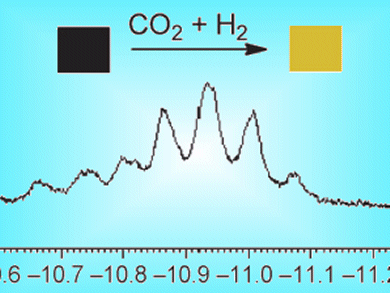The catalytic hydrogenation of CO2 or bicarbonates to give formic acid derivatives provides the basis for a renewable chemical feedstock. It has the potential to replace the use of the more toxic CO, which is currently utilized in industry on a million-ton scale. Noble-metal complexes have mainly been studied as catalysts for this transformation with good results. Cheaper, non-precious-metal catalysts have scarcely been investigated and the obtained catalytic activities are low with turnover numbers (TONs) <120.
Matthias Beller and co-workers, Rostock University, Germany, report cobalt dihydrogen complexes based on the tetraphos ligand (P(CH2CH2PPh2)3) for the catalytic hydrogenation of CO2 and bicarbonates. Hydrogenation of CO2 in methanol proceeded smoothly in 83 % yield with a TON of 659. The hydrogenation of CO2 was also possible at low pressures with TONs of around 60. Previously reported TONs at low H2 pressure are in the range of 9–16. For the hydrogenation of bicarbonates, a TON of 3877 was achieved. This is six times as high as the best non-precious-metal catalyst, and twice that of the best precious-metal system.
This represents a good starting point for further improvement of the hydrogenation reaction under ambient conditions and with low-cost metals.
Image: © Wiley-VCH
- Catalytic Hydrogenation of Carbon Dioxide and Bicarbonates with a Well-Defined Cobalt Dihydrogen Complex
C. Federsel, C. Ziebart, R. Jackstell, W. Baumann, M. Beller,
Chem. Eur. J. 2011.
DOI: 10.1002/chem.201101343



